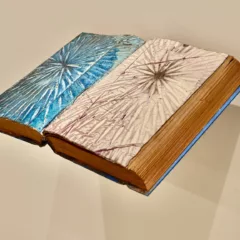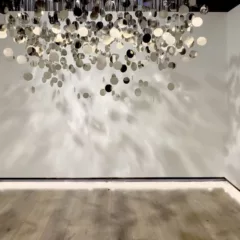
In 2020 The Future Is Us Collective will have its three-year anniversary. Since 2017, TFIU has been hosting pop-up exhibitions and events for Philadelphia youth artists through partnerships with local arts and community spaces (previous partners include Urban Art Gallery, Our House Culture Center, A Space, The Common Room, and Asian Arts Initiative). TFIU showcases high school and young adult artists, aiming to foster a community for creative youth that is powered by face-to-face engagement and encouragement instead of just ‘likes’ on social media. Last September, TFIU received their first grant from The Awesome Foundation and recently the collective’s founder, Laila Islam, was named an Andrew W. Mellon Undergraduate Curatorial Fellow at the Philadelphia Museum of Art. Her co-curator and organizational partner, Muhammad Gallashaw, is a high school senior who will be attending the University of the Arts as a Film major later this year.
Laila and Muhammad have been working together since they met in high school but do not make up TFIU alone. The artists are also collaborators. Some have been showcasing since the very beginning. The way the collective functions is fairly simple: an open call is shared, artists submit their work online and primarily do so through Instagram, and almost everyone who applies is granted entry. Not only can folks submit to open calls, they may also send questions to TFIU either via Instagram or their email, thefutureisuscollective@gmail.com. For young artists who are just starting out and need creative advice or leads on available resources, TFIU is here to help.
I sat down with Laila and Muhammad to learn more about how the Collective started, hurdles facing high school artists, and why TFIU is such an important space for young creators.
Logan Cryer: How did the two of you meet?
Muhammad Gallashaw: The way I know her is so weird. I followed her on Instagram before I even went to the same school as her. One day we were having a fire drill and I saw her and I was like fangirling. It was crazy. I commented on her Instagram like, “I saw you in school today!”
Laila Islam: Fangirling over Laila Islam that’s like unbelievable, I can’t even imagine…Yeah, so we met and we’ve been friends ever since. Muhammad has been showcasing at Collective shows since the first show. So when I decided I wanted this to be more of a team and not just a one person thing I asked him over anybody else.
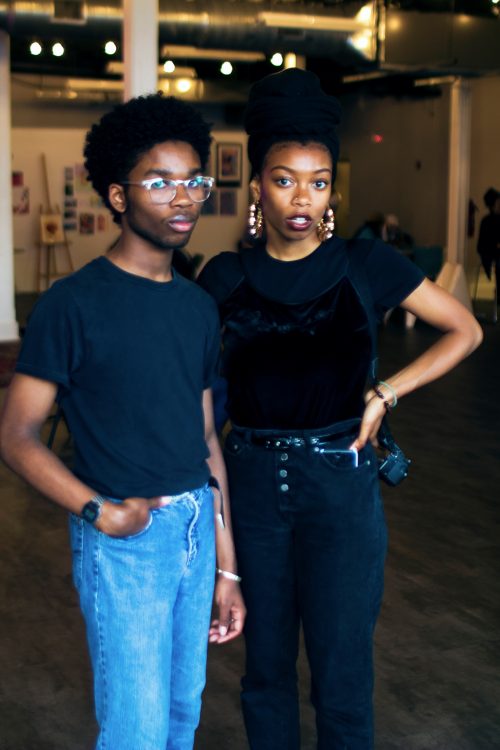
LC: What was TFIU like in the beginning?
LI: Our first fubu pop-up at Our House Culture Center in Germantown was eight artists and we were all contributing together. It was pretty much already functioning as a collective. Even by the second show it was all of us together.
MG: Minus a few people it was mostly the same group as the first. It started where it was eight of us showcasing together and then it started branching off where people would come and join whenever they wanted to.
LG: It was all youth artists in high school, if not their first year in college.
LC: From the times that I went to your show, it seems like aesthetically you all are getting a lot of overlap. How does that happen?
MG: I never even thought of that. When I go through submissions I just go through, look at people’s work, and everybody that submits is everyone that showcases. I think that’s just how it worked out.
LI: We try to emphasize organizing artists in a specific way. It’s not our biggest focus but we don’t allow artists to come in and place their work wherever they want. Because a lot of the artists are on a budget, they don’t have elaborate frames and they usually have prints and papers and canvases. That adds to the uniformness of it.
LC: I would think it has something to do with the way you’re promoting the shows. What is your outreach method? Mostly Instagram?
MG: Instagram for the most part, but if I know anybody that’s interested, I’ll reach out to them also.
LI: We tried flyers last year. I put as much out as I could. I enjoyed the process of putting them up and giving them to people, but I’m not entirely sure how productive it was. I would ask people when they came to the show how they found out about it and no one would say flyers. Now, we’re on Facebook and trying to expand on there too, especially because Facebook has an older demographic. If we have an older audience there could be more patrons for the artists that we showcase. I feel like that is really important.
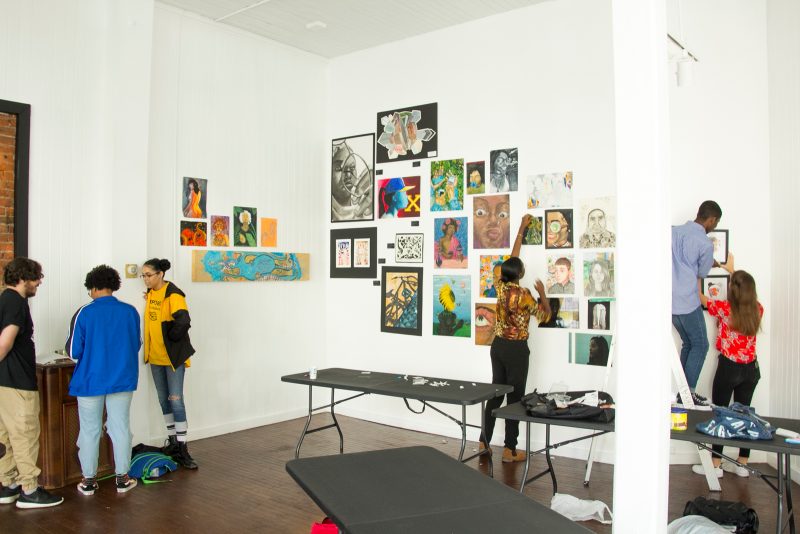
LC: What do you think is the biggest hurdle high school artists are facing right now?
MG: Well, since I’m still in high school I could definitely answer that question. I feel like the lack of money and how expensive everything is. Like, it’s so expensive to be an artist. I feel like you can do it with the bare minimum but it just don’t come out the same quality as people you look up to. When I was starting to draw and paint, I was so discouraged by the price of my supplies that I didn’t want to do it anymore and my mom was really pushing me to sell. I think a lot of young artists don’t know you shouldn’t sell your first couple of things. I think money is the most discouraging thing when it comes to being a high school artist because a lot of us don’t even have jobs.
LI: You were speaking on how some artists feel pressured to sell their work initially and this is even with people local philly artists that use music as a medium. Why are you publishing and putting out the first things that you’re doing for the entire world to see via internet? Why are you aiming to capitalize off of your first intimate creations? I feel like social media has a lot to do with that too, pressuring people to create content for an audience when you don’t even have an audience yet.
MG: I only just started posting stuff on Instagram and I’ve been doing this for a year.
LI: I feel like if you’re showcasing with our collective your only goal shouldn’t be to make money. It’s supposed to be an experience where you’re meeting other artists, you’re creating a space for people like you, and you’re getting inspired by other people. I feel like it’s that intention to just sell or produce is one of the things that is discouraging.
MG: You don’t have to be the most amazing artist in the world to showcase with us. We open our doors to people who are developing their artistry but are willing to take criticism and take guidance from other people who have already been in their shoes. It’s about sharing resources. I think we need to have more conversations about that. I didn’t know where to get cheap art supplies from. I still don’t know! But I know there are people out there that are out here striving on a good budget and through our events you have access to engage with people who know those kinds of things.
LI: I feel like I was just going to galleries and museums and I was seeing works that were like “The Greats” and artists making a living who were like 60-years-old and had been showcasing for decades. I feel like there should be a space where youth artists can go and see work that is at their same level so they can feel inspired to get better at various levels. Let’s say Salma Nolasco for example. Her technical skill is incredible and her concepts and are very nuanced and advanced. She’s been showcasing since she was a freshman in college and she’s incredible. I feel like having that young person with that kind of skill next to high school artists is inspiring and encouraging instead of having established artists already in the game for decades.
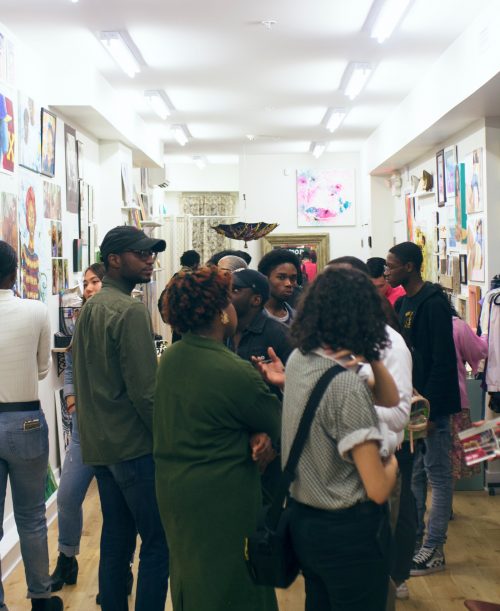
LC: So they’re not wondering, why doesn’t my work look like that?
LI: Or why am I not able to provide for myself right now. It’s because you’re 18!
LC: You both are so confident as curators and artists, how did you get to that point?
LI: For me, I grew up in poverty and it’s already ridiculously hard aspiring in the arts and gaining validation from family elders and educational institutions, even though my parents were very supportive of my aspirations. You gotta be out there, you can’t just sit. There’s some people who have the privilege to, but I’m like this because I never had that privilege. I never had people networking for me. It was always, you gotta go out to this thing.
MG: I definitely agree with that. I’ve been having to explain the fact that I wanna do art to a lot of people, a lot of times. I just think when you’re doing so much talking about what you want to do, when you get the opportunity to reach out to someone, you just wanna do it because you spent all this time validating it. All that hard work you don’t want it to go to shit.
LC: Do you have anything you’d like to share with the reader?
MG: Don’t be unmotivated by 8 likes. The amount of likes you get isn’t that deep. Network, keep persevering and keep shit going.
LI: Don’t be afraid to reach out to us. Email us. We would love to see a message from an artist asking any questions. We are a resource for emerging artists. Overall, always ask questions.
Be on the lookout, because The Future Is Us Collective has a new exhibition coming up at Cherry St Pier (dates TBA!)
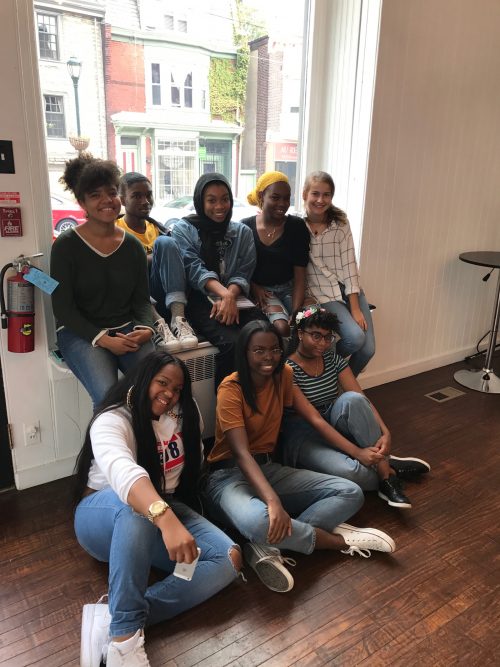
Bottom Row from Let to right: China McBride, Kym Clark, and Natera Kailyn



